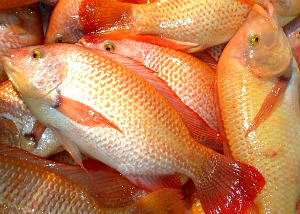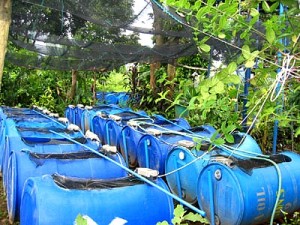 Red Tilapia was first introduced in the Philippines in 1980. These fishes have reddish or pink color, and famous for its fast growth rate and calm disposition. Red Tilapia is high in quality and price. It is usually cooked pasingaw or sweet and sour sacrificed to first class hotels and restaurants.
Red Tilapia was first introduced in the Philippines in 1980. These fishes have reddish or pink color, and famous for its fast growth rate and calm disposition. Red Tilapia is high in quality and price. It is usually cooked pasingaw or sweet and sour sacrificed to first class hotels and restaurants.
Red Tilapia Intensive Culture in Drum
This technology aims to be able to take care of many fish in small areas by intensive feeding, continuous aeration and water flow, and removal of dirt.
Benefits of Intensive Culture in Plastic Drum
- Good quality of fish.
- High yield.
- Just a small area needed.
- May control the quality of water.
- Rapid harvesting and feeding.
Two Systems of Intensive Culture in Drum
- Flow-through – continuous admission and release of water in the drum.
- Recirculating – continuous admission and release of water in the drum, the water appears to be filtered for reuse.
Critical Process needed in Recirculating Systems
- Aeration – for supply of oxygen.
- Clarification – the removal of solid waste.
- Biofiltration – removal of ammonia, nitrite and nitrate.
- Degassing – removing carbon dioxide
Note:
1. Keep the following:
a. Temperature – 24 to 32 ° C
b. Dissolved oxygen – 3 to 10 mg / L
c. Carbon Dioxide – 0 to 30 mg / L
d. pH – 6 to 8
e. Ammonia – 0 to 0.04 mg / L
2. Should be sufficient and continuous flow of water.
3. Deposit of 35-50 fish / drum.
Food
Use floating type of commercial feeds to:
- Be able to see if the fish are already full;
- Does not easily dissolve in water;
- Easy to remove excess food, and
- It does not affect to the good taste of the fish.
Amount and Frequency of Feeding
Daily Feed Ration (DFR) = ABW x N x FR
ABW = average body weight of fish
N = number of all fish
FR = feeding rate (10%, 8%, 5%)
- In the first month, provide the feed at weight of 10% by weight of fish per day.
- In the second month, make the feed 8% by weight of fish per day.
- From nine weeks until harvest, make the feed 5% of weight of fish per day.
Example:
If the weight per fish is five grams and 50 fish being cared:
DFR = 5g x 50 pieces x 10%
= 25 g / day
If the feeding is four times a day:
= 25 g / 4 feeding times
= 6.25g per feed
For more information, please contact:
BFAR Region 4A (CALABARZON)
2nd Floor, ICC Bldg., NIA Compound
EDSA, Diliman, Quezon City
Tel: (02) 926-8174
Fax: (02) 926-8616
Website: region4a.bfar.da.gov.ph
or
BFAR Region 4A – RFRDC
Freshwater Fisheries Research Station
Bambang, Los Baños, Laguna
Tel.: (049)827-3612 Fax: (049)536-8206
Source: region4a.bfar.da.gov.ph; Photos: fishfarmingbusiness.com, region4a.bfar.da.gov.ph
